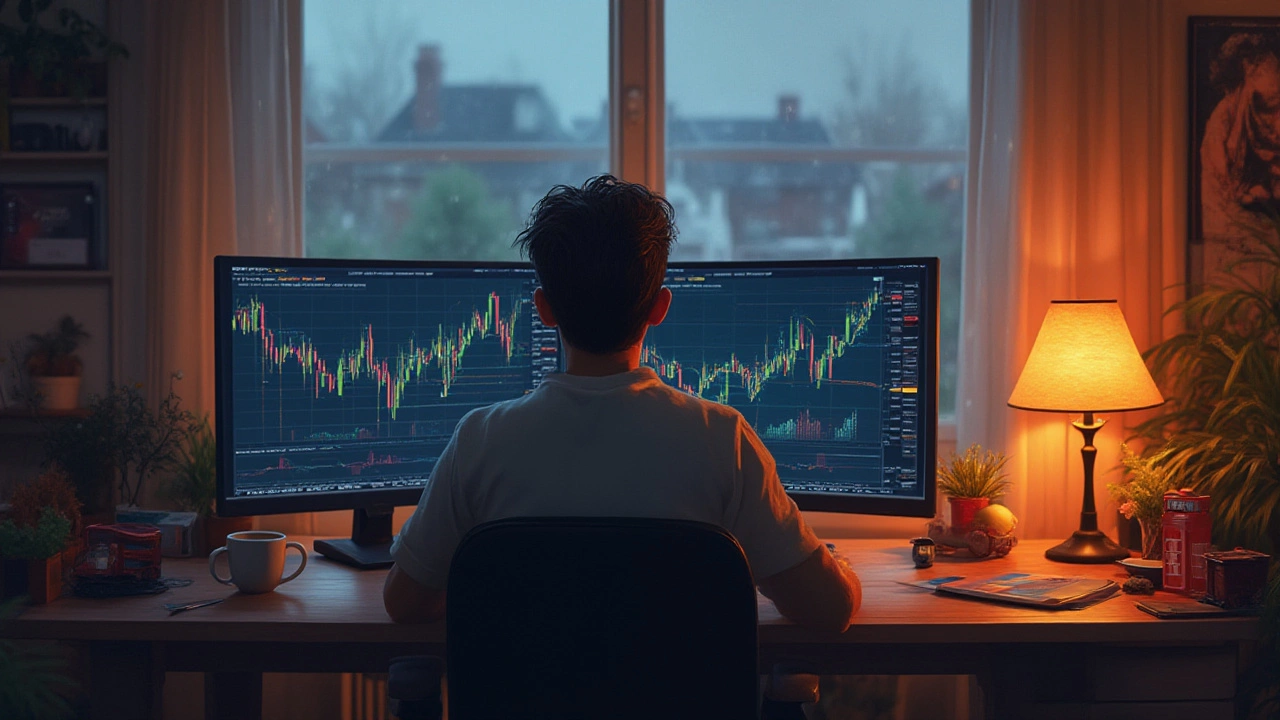Best Day to Buy Bitcoin: Cheapest Weekdays for Crypto Deals Explained
 Jul, 15 2025
Jul, 15 2025
So here’s a wild fact that might surprise you: Bitcoin, the world’s most famous cryptocurrency, isn’t just volatile by the month or year—it can swing wildly depending on the day of the week. Ever checked a Bitcoin price chart on Monday, blinked, and then wondered if you were looking at a totally different market by Thursday? You’re not alone. The idea that there’s a “cheapest day” to buy Bitcoin isn’t some internet myth—real data says the day you buy could actually make a difference in how much you get for your cash. But it's not just about luck or chance. The Crypto market never sleeps, but humans do, and so do the whales, traders and bots moving billions every day. That rhythm creates strange patterns in prices, and if you know when to jump in, you might just snag a better deal than your neighbor. Let’s break down how Bitcoin’s weekly price cycle really works—and if those Tuesday night purchases really are the secret handshake of smart crypto investors.
Bitcoin’s Weekly Price Cycle: Is There Really a Cheapest Day?
Okay, here’s the truth—Bitcoin trading looks like chaos, but there’s actually a method to the madness, especially when you dig into the weekly price cycle. Bitcoin, just like traditional assets, shows certain patterns that repeat more often than you’d think. Researchers at the crypto analytics firm Kaiko published a report in 2023 looking at years of Bitcoin data—and no joke, they found that Sunday and Monday are statistically the days when Bitcoin prices tend to be lowest. How did they figure it out? They measured daily closing prices across major exchanges like Binance, Coinbase, and Kraken, then averaged them out. The numbers backed up what many veteran traders already guessed. Let’s get down to numbers with an example: Imagine Bitcoin’s average Sunday closing price sits about 1% lower than the weekly average through 2023 and early 2024. Over a year, that tiny difference could mean hundreds or even thousands of dollars in gains if you time your buy window right—especially for big investors. For smaller buyers, that 1% might mean the difference between dinner out or eating ramen for a week (we’ve all been there).
So why are Sunday and Monday cheaper? It’s all about liquidity and trading volume. Saturdays and Sundays are slow for the classic financial world, and although Bitcoin trades 24/7, fewer people are active on weekends. This shrink in trading activity sometimes pulls prices down as there’s less demand and more hesitation to buy or sell. Mondays often start with traders catching up on news and setting positions for the week. That means many sellers want to cash out, pushing prices down a little further before the rest of the crowd jumps back in.
But—here’s the twist—those patterns aren’t set in stone. Holiday weeks, shock news, or major government actions can wreck these trends. In March 2024, for example, Bitcoin broke above $70,000 for the first time, but those old “cheap” days had barely any discount because buyers were flooding in seven days a week. So, the patterns are real, but not immune to big events.
| Day of the Week | Average Bitcoin Price Difference (vs. Weekly Avg, 2023-24) |
|---|---|
| Sunday | -1.1% |
| Monday | -0.9% |
| Tuesday | 0.2% |
| Wednesday | +0.4% |
| Thursday | +0.7% |
| Friday | +0.4% |
| Saturday | +0.3% |
It pays to remember: knowing the average is good, but nothing in crypto is guaranteed. Prices dip and spike for unpredictable reasons. But if you’re looking for a concrete answer, Sunday and Monday win as the statistically cheapest days for Bitcoin, on average, over the past two years.

Why the Day-of-the-Week Effect Happens (And When It Breaks Down)
This all feels strange, right? Shouldn’t an open, 24/7 market smooth out weird price cycles? Turns out, not so much. The day-of-the-week effect isn’t just a weird Bitcoin quirk. It’s shown up in stock and forex markets for decades. The big idea here is simple: human behavior repeats, and when enough people act out of habit, the market reflects it. With Bitcoin, a few quirks in how the crypto world works feed into this effect.
First, there’s the “weekend lull.” Fewer active traders means smaller trades move the market more. So, it’s easier for prices to dip on thin volume. When a whale (think of a mega-rich investor) dumps coins on a Saturday, there aren’t enough buyers to cushion the fall, so the price slides easier. But let’s turn the tables—the same thin market means prices could surge if a big buy order lands. It’s just that, for now, the data points to small drops being likelier on Sundays and Mondays. Next, Asia and Europe are big players in crypto, and their Monday mornings can set the tone for the day. If negative weekend news breaks in the U.S., traders in Hong Kong or Berlin often react first come Monday—amplifying dips. That’s something you don’t see as clearly in U.S. stock markets, which pause for weekends.
So this all lines up nicely—except when it doesn’t. When does the pattern break? The obvious answer: during bull runs, panics, or regulatory bombshells. Look at April 2024, when rumors of a Bitcoin ETF in Hong Kong pushed the market wild for four straight days—the day-of-week pattern? Basically gone. Volatility and panic buying made the normal “rules” seem like ancient history.
It’s also interesting that as the crypto world grows up, these cycles are getting slightly weaker each passing year. Computer trading (algos), overseas buying, and all-hours trading bots help smooth out the nastiest price swings. Still, the human schedule—the tendency to get bold on Wednesdays and chicken out before Sunday dinner—remains big enough to leave its mark. Don’t expect price differences as huge as the early days, but yes, that Monday dip hasn’t vanished yet in 2025.
If you’re hoping to get scientific, you can actually track these changes yourself. Loads of sites like Coingecko and Messari let you grab historical Bitcoin prices and graph by day of the week. Some hobbyist coders even plug this data into Google Sheets or Python scripts to watch for changing trends. For those with patience, this DIY approach can actually spot when the day-of-week effect grows or shrinks—and might even warn you if this old-school trick is fading or getting stronger again.

Smart Buying Tips: How to Nab Bitcoin at the Best Price
So you want to snag Bitcoin on the cheap? Good news—it’s not rocket science, but it does pay to play it smart. Chasing the “perfect” price is tough, even for pros. Here are a few tricks that actually work if you want to maximize your odds.
- Watch the Sunday-Monday dip: No, it’s not guaranteed, but if you’re buying regularly, consider setting those buys for late Sunday or early Monday (UTC time, for best results).
- Automate your buys with Dollar Cost Averaging (DCA): Even the pros can’t always time the market. DCA lets you buy a fixed amount of Bitcoin on the same day every week or month—removing emotions and helping you snag dips almost by accident. Top exchanges like Coinbase and Binance let you set this up with two clicks.
- Keep an eye on global news: Even a tweet from a major company or a government ruling can make a bigger impact than any day-of-week trend. Always check Twitter, Reddit, or crypto news sites before hitting “buy.”
- Follow the whales: Websites like Whale Alert let you see when massive sums are on the move. If you notice lots of big transfers happening Sunday night, there may be a price swing coming soon.
- Don’t FOMO: The fear of missing out is every crypto investor’s enemy. Price spiked on Thursday? Don’t chase it blindly hoping for gains. The cheapest day to buy Bitcoin is usually when nobody else is talking about crypto on social media.
- Fees matter! Even if you grab a Sunday dip, high exchange fees can wipe out your savings. Always compare the total cost—including “hidden” withdrawal fees.
- Compare charts on multiple exchanges: Prices don’t always match. Sometimes you’ll spot a small patch of discount if one exchange lags behind others.
You’ve probably heard it a thousand times—never invest more than you can afford to lose. Bitcoin’s still as jumpy as a squirrel on coffee, and no “trick” can guarantee bottom-dollar prices every week. But if you play the odds, time your buys around the quieter start of the week, and lock down your emotions, you’ll probably edge out the folks panic-buying every Friday. And seriously, if you’re deep into tracking that sweet buy window, try linking notifications to your exchange or setting up a price alert—sometimes the best deal shows up at the weirdest hour.
If you like digging into stats, here’s a quick look at average price moves from 2023 to mid-2025, pulled from daily CoinMarketCap data:
| Year | Cheapest Avg. Day | Typical Discount (%) |
|---|---|---|
| 2023 | Sunday | -1.2% |
| 2024 | Monday | -0.9% |
| 2025 (Jan-Jul) | Monday | -0.7% |
One last thing? Anybody trying to sell you a “guaranteed Bitcoin buy alert” service for big bucks is selling snake oil. All you need is some common sense, a few good charts, and the patience to buy when everyone else is watching Sunday night TV instead of crypto prices. Be the calm one—crypto rewards the chill investors, not the twitchy ones. Happy hunting!
